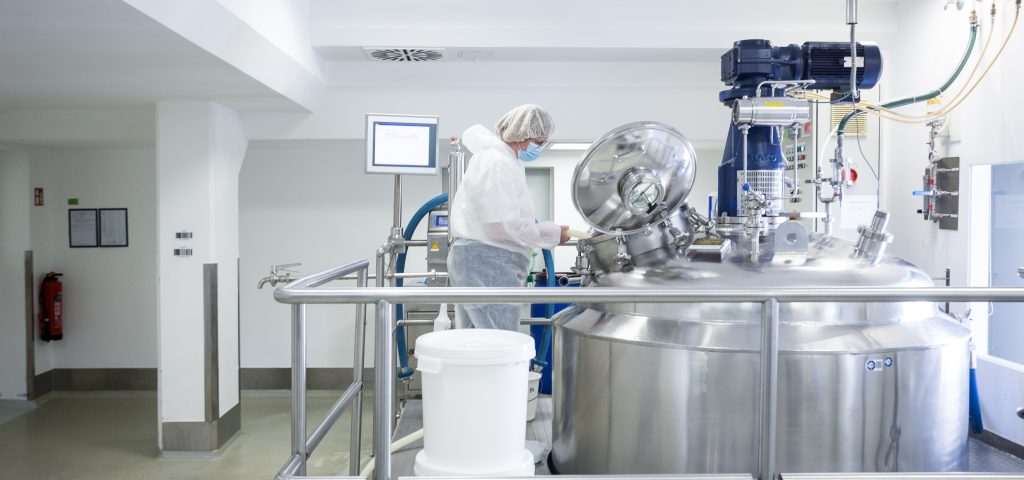The pharmaceutical industry constantly seeks innovations to improve efficiency, product quality, and sterility. Pharmaceutical filling machines are critical in achieving these goals. In this blog post, we will delve into the recent advancements at our Leipzig facility, where two new filling lines have been introduced to increase production capabilities.
Pharmaceutical Filling Machines: What Are They?
Pharmaceutical filling machines, or filling lines, are crucial equipment used in the pharmaceutical industry. They automate the process of filling containers—such as vials, bottles, or syringes—with pharmaceutical products. These systems ensure accuracy, sterility, and efficiency, which are essential for maintaining product quality and meeting regulatory standards.
New Filling Machines at our Leipzig Facility
We have expanded our production capacity with two new filling lines: the half-automatic Würschum Line and the fully automatic Groninger Line. The Leipzig facility now hosts a total of five production lines: three for liquid manufacturing and two for semi-solids.
Capacity of the New Filling Machines
Understanding production capacity is crucial for effective planning and resource allocation. The Würschum Line is a half-automatic filling station with a real output of up to 10 bottles per minute.
In contrast, the Groninger Line is a fully automatic filling line that offers a significantly higher throughput. It can process up to 90 bottles per minute. This huge capacity ensures us to meet growing market demands and support various production volumes.
Types of Products Handled
Both new filling lines are versatile, capable of handling a range of product types. They are designed to fill low to medium viscosity products, catering to various pharmaceutical formulations.
- Würschum Line: This line can handle bottles ranging up to 1000ml in nearly any format—round, square, oval, etc. It offers two capping systems: a screwhead system with torque and a belt system.
- Groninger Line: This line specializes in round bottles ranging up to 250ml. It features six filling stations and robust inertisation capabilities.The Groninger Line is equipped with two capping stations, one crimping station (with the potential for modification to an automatic roll-on system), and stations for automatic feeding of spoons and manual insertion of syringes and pipettes.
Ensuring Product Quality and Sterility
Maintaining product quality and sterility is paramount in pharmaceutical manufacturing. The Groninger Line incorporates several aseptic processing techniques to ensure high-quality, sterile products. Key features include:
- Blowing Station: This station removes particles from bottles, ensuring contamination-free filling.
- Cleanroom Conditions: The line operates under stringent cleanroom conditions to prevent contamination.
- Environmental Monitoring: Continuous monitoring ensures a controlled environment, maintaining sterility throughout the filling process.
Handling Different Container Sizes and Formats
Both new lines are designed for versatility. The Würschum Line can handle various bottle sizes and shapes, while the Groninger Line is specialized for round bottles. This flexibility allows us to fill a wide range of pharmaceutical products, meeting diverse client needs.
Validation and Qualification Processes
Ensuring the new filling lines meet regulatory standards is critical. The validation and qualification processes for the Würschum and Groninger Lines are already underway, ensuring they adhere to all required production standards before full-scale operations commence.
Integration with Existing Systems
While the new filling lines do not integrate with existing systems, they follow the same workflow used across our production lines. Data exchange is managed through the secure Data-Net system, ensuring efficient and streamlined operations.
The introduction of the Würschum and Groninger filling lines at our Leipzig facility represents a significant advancement in pharmaceutical manufacturing. These brand new machines enhance production capacity, improve versatility, and maintain stringent quality and sterility standards. This investment shows our commitment to innovation and excellence in the pharmaceutical industry.
FAQs about Pharmaceutical Filling Machines
What is filling in pharma?
In the pharmaceutical industry, filling refers to the process of accurately dispensing a specific quantity of a pharmaceutical product into containers such as vials, bottles, or syringes. This process is crucial for ensuring dosage accuracy, maintaining sterility, and improving efficiency.
What is a vial filling machine?
A vial filling machine is specialized equipment used in the pharmaceutical industry to fill vials with liquid medications. These machines ensure precision and sterility, which are essential for maintaining product quality and meeting regulatory requirements.
What equipments are used for filling?
Equipments used for filling in the pharmaceutical industry include various types of filling machines, conveyors, capping machines, labeling machines, and sterilization units. These machines work in unison to ensure efficient, accurate, and sterile filling of pharmaceutical products.
What are the different types of filling machines?
Different types of filling machines include volumetric filling machines, gravimetric filling machines, piston filling machines, and peristaltic filling machines. Each type is designed for specific applications and types of products, helping to ensure accuracy and efficiency in the filling process.
What instruments are used for fillings?
Instruments used for filling include syringes, pipettes, nozzles, and filling needles. These instruments are often integrated into automated filling machines to ensure precise dispensing of pharmaceutical products.
How do I choose a filling machine?
Choosing a filling machine involves considering factors such as the type of product being filled, container size and shape, required filling speed, and desired accuracy. Additionally, it’s essential to consider the machine’s compatibility with existing production systems and regulatory compliance.
What are the supplies used for filling?
Supplies used for filling include containers (such as vials, bottles, and syringes), caps, seals, labels, and sterile materials. These supplies are essential for ensuring the integrity, safety, and efficacy of the filled pharmaceutical products.
